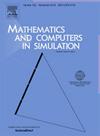Robust regulation of blood glucose for Type-1 diabetes using insulin infusion limiter-based feedback control via artificial Pancreas
IF 4.4
2区 数学
Q1 COMPUTER SCIENCE, INTERDISCIPLINARY APPLICATIONS
引用次数: 0
Abstract
This paper studies the feedback control of blood glucose concentration in Type-1 diabetes patients (T1DPs) through an artificial Pancreas via the glucose monitoring and insulin pump. For an artificial Pancreas, insulin infusion through a pump has been adapted by respecting the desired insulin infusion range for a patient. The insulin range has been incorporated by considering the lower and upper limits on the insulin infusion rate, which are maintained for a patient through the application of an asymmetric saturation nonlinearity (rate limiter). By incorporating the infusion rate range, the Bergman’s model of T1DPs via the saturated insulin input has been revised for attaining an improved model. To deal with the asymmetric saturation nonlinearity for positive systems, arising due to specific consideration of diabetes patients model, analytical investigations in terms of an inequality and signal transformation have been revealed. To control the glucose level and to keep the delivery of insulin within prescribed limits, a local feedback control strategy by application of the proposed analytical investigation of the nonlinearity has been provided. The proposed automatic control approach is more safe for a T1DP than the existing methods due to consideration of the desired insulin rate limits and positive input. In addition, a robust regulation strategy against variation in the glucose level, caused by the food intake, has also been provided in terms of linear matrix inequalities. The attained results can be applied for manufacturing a better device for the purpose of blood glucose regulation in T1DPs. A comparative simulation study to demonstrate the superiority of the proposed scheme has been provided at the end.
基于胰岛素输注限制器的人工胰腺反馈控制对1型糖尿病血糖的稳健调节
本文研究了人工胰腺通过血糖监测和胰岛素泵对1型糖尿病患者血糖浓度的反馈控制。对于人工胰腺,通过泵的胰岛素输注已经适应了尊重患者所需的胰岛素输注范围。胰岛素范围是通过考虑胰岛素输注速率的下限和上限来纳入的,通过应用不对称饱和非线性(速率限制器)来维持患者的输注速率。通过纳入输注速率范围,通过饱和胰岛素输入对Bergman的T1DPs模型进行了修订,以获得改进的模型。为了处理由于糖尿病患者模型的特殊考虑而引起的正系统的不对称饱和非线性,揭示了从不等式和信号变换方面的分析研究。为了控制血糖水平并使胰岛素的输送保持在规定的范围内,应用所提出的非线性分析研究提供了一种局部反馈控制策略。由于考虑到所需的胰岛素速率限制和正输入,所提出的自动控制方法对T1DP比现有方法更安全。此外,根据线性矩阵不等式,还提出了一种针对食物摄入引起的葡萄糖水平变化的强大调节策略。所得结果可用于制造更好的T1DPs血糖调节装置。最后通过仿真对比研究证明了该方案的优越性。
本文章由计算机程序翻译,如有差异,请以英文原文为准。
求助全文
约1分钟内获得全文
求助全文
来源期刊

Mathematics and Computers in Simulation
数学-计算机:跨学科应用
CiteScore
8.90
自引率
4.30%
发文量
335
审稿时长
54 days
期刊介绍:
The aim of the journal is to provide an international forum for the dissemination of up-to-date information in the fields of the mathematics and computers, in particular (but not exclusively) as they apply to the dynamics of systems, their simulation and scientific computation in general. Published material ranges from short, concise research papers to more general tutorial articles.
Mathematics and Computers in Simulation, published monthly, is the official organ of IMACS, the International Association for Mathematics and Computers in Simulation (Formerly AICA). This Association, founded in 1955 and legally incorporated in 1956 is a member of FIACC (the Five International Associations Coordinating Committee), together with IFIP, IFAV, IFORS and IMEKO.
Topics covered by the journal include mathematical tools in:
•The foundations of systems modelling
•Numerical analysis and the development of algorithms for simulation
They also include considerations about computer hardware for simulation and about special software and compilers.
The journal also publishes articles concerned with specific applications of modelling and simulation in science and engineering, with relevant applied mathematics, the general philosophy of systems simulation, and their impact on disciplinary and interdisciplinary research.
The journal includes a Book Review section -- and a "News on IMACS" section that contains a Calendar of future Conferences/Events and other information about the Association.
 求助内容:
求助内容: 应助结果提醒方式:
应助结果提醒方式:


